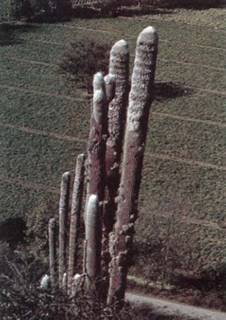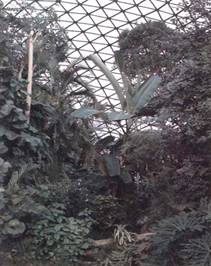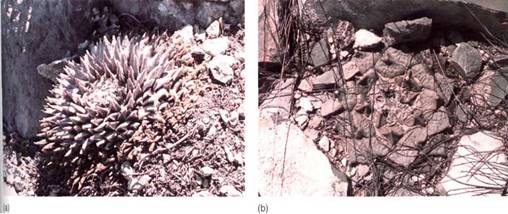


 النبات
النبات
 الحيوان
الحيوان
 الأحياء المجهرية
الأحياء المجهرية
 علم الأمراض
علم الأمراض
 التقانة الإحيائية
التقانة الإحيائية
 التقنية الحيوية المكروبية
التقنية الحيوية المكروبية
 التقنية الحياتية النانوية
التقنية الحياتية النانوية
 علم الأجنة
علم الأجنة
 الأحياء الجزيئي
الأحياء الجزيئي
 علم وظائف الأعضاء
علم وظائف الأعضاء
 الغدد
الغدد
 المضادات الحيوية
المضادات الحيوية|
Read More
Date: 18-10-2016
Date: 16-10-2016
Date: 23-10-2016
|
Taxonomic Studies
EXPLORATION AND DISCOVERY
People have been hunting for and discovering new plant types since before recorded history to find not only new food plants but also ornamental plants and beautiful woods . Exploration continues today as biologists enter new areas that either have never been explored or have been visited only once or twice. Tropical rainforests of Brazil, Central America, Africa, and Southeast Asia are so poorly explored that any serious expedition returns with previously unknown species of plants and animals. New species of birds are routinely discovered in the mountainous regions of Peru. Most North Americans have difficulty understanding how inaccessible many of these regions are; exploration must often be done on foot, carrying all supplies, and simply walking 3 or 4 miles in one day can be a major accomplishment. Of course, the pace is slower when one stops to examine, photograph, collect, and preserve plants. Field notes must be made as to flower color, plant height, ecology, pollinators, and neighboring plants. At a different season, other plants are in flower or fruit, some plants have died, and the seeds of different species may have germinated; a new exploration of the same area would encounter many new species but fail to find some that had been present during the first exploration. Some plants are less than 1 cm tall when fully grown and have an extremely limited range; it is easy to walk past them without noticing them (Fig. 1). On the other hand, the giant old man cacti are too big to overlook, but they grow in only three small valleys in Mexico and thus can easily be missed by explorers (Fig. 2). Finally, a species may resemble others so closely that a scientist may ignore it, thinking it is already well known; the fact that it is a new species might be revealed only by careful study of certain details.

FIGURE 1: This Lipanthes orchid is fully grown; even in full flower, it could be overlooked easily. Photo is twice life size.

FIGURE 2:These old man cacti (Cephalocereus senilis) are easily visible, but they occur in so few areas that it was easy for explorers to miss them for years.
Botanical exploration is also concerned with discovery of new facts about already recognized species. No species is made up of absolutely identical individuals, so numerous samples must be collected to gather information about the variability of its features as well as its geographical and ecological range (Fig. 3). Exploration may be dedicated to gathering either seeds or live material so that the plant can be propagated for research, horticulture, or food. Now that recombinant DNA techniques make it possible to transfer genes from one species to another, live preservation of as many species as possible is particularly important. Although much botanical exploration is carried out by botanists based at universities, a large share, perhaps even more than half, is done by members of botanical gardens and commercial nurseries (Fig. 4).

FIGURE 3:The geographical distribution of the genus of beans (Phaseolus) is already well-known in many regards, but certain species are relatively unstudied, especially their ecology and distribution in some parts of Mexico and Central and South America. This and other familiar genera still must be investigated, both to discover new species and to refine our concepts about which species are most closely related. (Based on data of A. Delgado, Universidad National Autonoma de Mexico).

FIGURE 4:This is part of the Missouri Botanical Garden in St. Louis, one of the most active botanical gardens in the world, sponsoring research by its own scientists and helping both graduate and undergraduate students to do field work. In addition, it organizes many international conferences and projects. The New York Botanical Garden is equally important and has been responsible for fundamental discoveries of plant classification for more than 100 years. A tew other particularly large gardens in the United States are the Fairchild Tropical Gardens in Miami, the Huntington Botanical Garden in Los Angeles, and the USDA Plant Introduction Gardens in Miami.
PRELIMINARY STUDIES OF NEW PLANTS
Preliminary studies of newly collected plants include many diverse activities. Specimens must first be identified using diagnostic keys and personal knowledge. An experienced taxonomist often recognizes the family of an unfamiliar species almost immediately; even the genus may be obvious. If so, further identification is usually simple. In an unfamiliar region in which many species are unknown, identification can be more difficult, and numerous characters must be studied and compared to those in published descriptions of the plants of the area.
If the plant can be identified, it may be studied to see it provides new information about the species. Even if it turns out to be absolutely typical in every way, that too is important. If the specimen cannot be identified or if it does not match any description, the taxonomist may suspect that it is a new species. Typically, the specimen is then sent to a specialist experienced with the species most closely related to the specimen.
Declaring a plant to be a new species is easy; proving it and describing it properly are difficult. Anyone can declare a plant to be a new species, name it, and write about it, even if it is obviously not a new species; this has caused countless problems. To overcome this, taxonomists from all over the world have established an International Code of Botanical Nomenclature that describes precisely the steps necessary for naming a new species. A valid name, one never previously used, must be declared and must be accompanied by a detailed description of the species in Latin and usually also in English, French, German, Spanish, or Russian. The name and description must be published in a widely circulated journal, a step that prevents many problems. The journal's editors send the description to at least two independent specialists to verify that it is a previously unknown species and that the name has never been used before. The description must also include the designation of a type specimen; this is a single preserved plant that truly carries Ute name (Fig. 5).

FIGURE 5:The type specimen of Sedum laxum subsp. flavidum (a) and a plant growing in the field (b). courtesy of M. Denton, University of Washington).
When new species are named, very little is known about them; as more research is carried out in the following years, enough variation may be discovered to warrant the recognition of a second species. For example, the range of leaf sizes, types of trichomes, and types of nectaries may warrant classification into two or three species. The original type specimen determines which type of leaf size, trichome, and nectary goes with the first name. When doubt arises as to which type of plant goes with which name, the type specimen must be checked. Herbaria tend to be extremely generous and willingly ship thousands of specimens to various botanists whenever a new project is started to study a genus or family. Type specimens, however, are often kept in special fireproof cabinets and are not allowed out of the herbarium. During World War II, Allied bombing destroyed the herbarium in the Berlin Botanic Garden, and thousands of type specimens burned to ashes. Germans had been very active in plant exploration during the first part of this century and much of the 1800s, and the loss of those type specimens has caused tremendous problems To prevent a recurrence of this disaster, other specimens, as similar as possible to the type specimen, are sent to many herbaria around the world; these are isotypes.
BIOSYSTEMATIC AND EXPERIMENTAL STUDIES
As species are discovered and named, they are assigned to families and genera according to the information then known about the specimen and the concept of the family or genus to which it is assigned. But the discovery of a new species must change our concept of the genus, family, and perhaps even the order to which it is assigned, because the species represents new information.
Similarly, new studies on recognized species can change our concept of them and of how they are classified. They may be found to have a particular wood structure or a class of defensive compounds which is unknown in the family in which they are classified but does occur in other groups. There is then the problem of deciding whether the newly discovered features are the result of convergent evolution or the species has been misclassified. Over a period of years, problems such as this accumulate in many groups, and periodically someone decides the group needs a detailed study of all its members and of other related groups. Specimens are requested from many herbaria, and perhaps field trips are undertaken to gather either new specimens or more accurate ecological, geographical, and pollination information. Journals are searched for studies of anatomy, physiology, and anything else that may be useful. New studies may be undertaken, especially using newer techniques of scanning electron microscopy, phytochemistry, plastid DNA sequencing, rRNA sequencing, and so on, that were not available when the original descriptions were written. Often, data about species and characters are so abundant that computer techniques are used to evaluate and sort them and suggest possible phylogenies.
Such studies often take many years because of the large number of factors being analyzed. In the end, large genera or families may be divided into several smaller ones if the scientist is convinced that there are several major lines of evolution rather than one. On the other hand, he or she may decide to combine genera into a more broadly defined genus, or a few species may be transferred from one genus to another, perhaps even to a different family. Frequently, these studies discover that certain names are not valid: The name had been used previously for a different species or had not been validly published because no type specimen had been designated or Latin description written. Surprisingly often, a particular commonly used scientific name is found never to have been published at all (Fig. 6).

FIGURE 6 (a) This cactus species is currently named Ariocarpus returns, but its name has changed through the years. It was named Anhalonium prismaticum in 1839, but later studies (1898) of the literature revealed that the species had actually been named Ariocarpus retusus before 1839; as the first name published, it had precedence and the name Anhalonium had to be abandoned. The complete list of synonyms used since 1839 includes 17 names. (b) Ariocarpus jurfuraceus. Some taxonomists believe that plants with this phenotype constitute a subspecies of Ariocarpus retusus. Others believe fay are closely related but separate species. (Photographs courtesy of C. Glass and R. Foster, Abbey Garden Press).
The results of the study are published as a major report, usually called a monograph. Naturally these vary in quality, but a good one has extensive summaries of all pertinent data, maps of geographical distribution, names and numbers of the herbarium specimens examined, and carefully prepared documentation of nomenclature. Any change in the scientific epithet of a species, either genus or species name, must be declared and explained, and a complete list of the previous names must be presented. For most species, £w studies have resulted in name changes, so there may be only one or two previous names. But for other species, dozens of previous names are not unusual, reflecting the history of uncertainty about the phylogeny of the species or its group.
Periodically an individual publishes a monograph on all flowering plants or even all vascular plants. The most recent comprehensive monograph of the flowering plants is An Integrated System of Classification of Flowering Plants by Dr. Arthur Cronquisl of the New York Botanical Garden. It presents both classes of flowering plants (see Chapter 25) and all the subclasses, orders, and families, giving diagnostic features of each, comparing each with its relatives, and discussing the major events of evolution in the flowering plants. The books Paleobotany: An Introduction to Fossil Plant Biology by Drs. Thomas N. Taylor and Edith L. Taylor and Paleobotany and the Evolution of Plants by Drs. Wilson N. Stewart and Gar W. Rothwell describe the major groups of extinct plants and discuss all the known main lines of plant evolution since plants become distinct from algae about 400 million years ago.



|
|
|
|
كيف تعزز نمو الشعر الصحي؟
|
|
|
|
|
|
|
10 فحوصات مهمة يجب القيام بها لسيارتك قبل الصيف
|
|
|
|
|
|
جامعة الزهراء (عليها السلام) تكرم قسم الشؤون الفكرية بمناسبة اليوم العالمي للكتاب
|
|
|
|
قسم شؤون المعارف يقيم ندوة علمية حول جهود علماء البصرة في نشر الحديث
|
|
|
|
قسم الشؤون الفكرية يختتم برنامجاً ثقافياً لوفدٍ من جامعة البصرة
|
|
|
|
جامعة الكفيل تعقد ورشة عمل عن إجراءات عمل اللجان الامتحانيّة
|